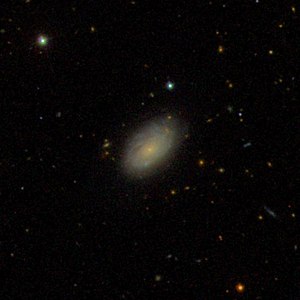NGC 4964
| Galaxy NGC 4964 |
|
|---|---|

|
|
| SDSS | |
| AladinLite | |
| Constellation | Big Bear |
|
Position equinox : J2000.0 , epoch : J2000.0 |
|
| Right ascension | 13 h 05 m 24.8 s |
| declination | + 56 ° 19 ′ 22 ″ |
| Appearance | |
| Morphological type | Sat |
| Brightness (visual) | 13.1 mag |
| Brightness (B-band) | 14.1 mag |
| Angular expansion | 1.1 ′ × 0.6 ′ |
| Position angle | 134 ° |
| Surface brightness | 12.5 mag / arcmin² |
| Physical data | |
| Affiliation | isolated |
| Redshift | 0.008406 ± 0.000147 |
| Radial velocity | 2520 ± 44 km / s |
|
Stroke distance v rad / H 0 |
(117 ± 8) x 10 6 ly (35.9 ± 2.6) Mpc |
| history | |
| discovery | Wilhelm Herschel |
| Discovery date | April 14, 1789 |
| Catalog names | |
| NGC 4964 • UGC 8184 • PGC 45278 • CGCG 294-011 • MCG + 09-22-007 • IRAS F13032 + 5636 • 2MASX J13052487 + 5619216 • GC 3403 • H III 779 • h 1532 • | |
NGC 4964 is a 13.1 mag bright lenticular galaxy of the Hubble-type S0 in the constellation Great Bear in the northern sky . It is estimated to be 117 million light years away from the Milky Way and has a diameter of around 35,000 ly.
In the same area of the sky is the galaxy NGC 4977 .
The object was discovered on April 14, 1789 by Wilhelm Herschel with an 18.7-inch reflector telescope, who described it as "vF, S".
